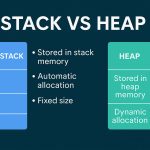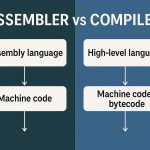Description
Zero-Based Indexing is a fundamental concept in computer science and programming where index counting begins at 0 instead of 1. In zero-based systems, the first element of an array, list, or sequence is accessed using index 0, the second with index 1, and so on.
This indexing convention is widely adopted in many programming languages and data structures because of its close alignment with pointer arithmetic, memory addressing, and mathematical logic in computing.
Example
Array Representation
arr = ['a', 'b', 'c', 'd']
print(arr[0]) # Output: 'a'
print(arr[3]) # Output: 'd'arr[0]= first elementarr[1]= second elementarr[n-1]= nth element (ifnis length of array)
Supported Languages (Zero-Based)
Most popular languages use zero-based indexing by default:
| Language | Indexing Style |
|---|---|
| C | Zero-based |
| C++ | Zero-based |
| Java | Zero-based |
| Python | Zero-based |
| JavaScript | Zero-based |
| Go | Zero-based |
| Swift | Zero-based |
| Kotlin | Zero-based |
| Rust | Zero-based |
Alternative: One-Based Indexing
Some languages and environments use one-based indexing, meaning the first element has index 1.
| Language / System | Indexing Style |
|---|---|
| MATLAB | One-based |
| Fortran | One-based |
| Lua | One-based |
| R (mostly) | One-based |
| Excel formulas | One-based |
Why Zero-Based Indexing?
1. Pointer Arithmetic (Low-Level Explanation)
In low-level memory models like C:
arr[0] == *(arr + 0)Here, arr is a pointer to the first memory address. Indexing from zero makes the offset directly correspond to the index.
2. Simpler Offset Calculation
For an element at position i, the memory offset is simply:
address = base + i * size_of_elementNo need for -1 corrections.
3. Range Definition Elegance
Using zero-based indexing simplifies inclusive/exclusive ranges:
for i in range(0, len(arr)): # clean iteration
print(arr[i])This logic works well with slicing:
arr[0:3] # returns ['a', 'b', 'c']Advantages of Zero-Based Indexing
| Benefit | Explanation |
|---|---|
| Mathematical alignment | Works better with modular arithmetic and offsets |
| Compatibility with C | Language ancestors used 0-indexing |
| Efficient memory model | Direct correspondence with pointer offsets |
| Slicing simplicity | Cleanly defines ranges like [start:end) |
Drawbacks / Criticisms
| Issue | Description |
|---|---|
| Less intuitive for beginners | Most humans naturally start counting from 1 |
| Off-by-one errors | A common bug due to forgetting 0-based offset |
| Context switch | Switching between 0 and 1-based systems is error-prone |
Zero-Based Indexing in Slicing and Loops
Python Example:
arr = [10, 20, 30, 40, 50]
print(arr[0:3]) # [10, 20, 30]This prints elements at indices 0, 1, and 2 — the end index is exclusive.
Looping:
for i in range(len(arr)):
print(f"Element {i} is {arr[i]}")Zero-Based Matrix Indexing
In 2D arrays or matrices:
matrix[0][0] # top-left corner
matrix[2][3] # 3rd row, 4th columnThis indexing is consistent with array of arrays memory layout and is especially useful in image processing, game development, and simulations.
Common Bugs and Best Practices
Off-by-One Error:
This occurs when developers accidentally go out of bounds due to incorrect start/end conditions.
Best Practices:
- Always check
len(array)before accessing by index. - Use
enumerate()in Python for safe indexed loops. - Prefer slice syntax where applicable.
Zero-Based Indexing in Data Structures
| Structure | Uses Zero-Based Indexing |
|---|---|
| Arrays | Yes |
| Lists | Yes |
| Strings | Yes |
| Tuples | Yes |
| Stacks / Queues | Depends on implementation |
| Heaps | Often starts from index 1 |
Historical Note
The concept of zero-based indexing dates back to BCPL and C programming languages in the 1960s and 70s. It was adopted for:
- Efficiency
- Consistency with hardware memory addressing
- Simpler implementation of dynamic arrays and strings
It became widespread through C and influenced most modern languages.
Zero-Based Indexing in Education and UI
In programming education or UI tools:
- Beginners may find it confusing (e.g., “first item is at 0?”).
- Many educational tools highlight the 0-based convention explicitly.
- Some interfaces (e.g., Excel) mask this by using 1-based cell numbers.
Zero-Based vs One-Based: Comparison Table
| Criteria | Zero-Based | One-Based |
|---|---|---|
| Index starts from | 0 | 1 |
| Used in | Most modern programming langs | MATLAB, Fortran, Lua |
| Memory efficiency | High | Slightly less efficient |
| Beginner-friendly | Less intuitive | More intuitive |
| Mathematical model | Aligns with modulo, offsets | Aligns with human counting |
Transitioning Between Indexing Styles
If working with both systems:
- Always document which indexing is in use.
- Use helper functions to convert:
def one_to_zero(i):
return i - 1
def zero_to_one(i):
return i + 1Related Terms
- Array
- Pointer Arithmetic
- IndexError
- Slicing
- Loop Bounds
- Off-by-One Error
- Base Address
- Range Function
- Memory Layout
- One-Based Indexing
Conclusion
Zero-Based Indexing is a foundational concept in programming and computer science. It is favored for mathematical rigor, memory efficiency, and logical consistency, especially in low-level languages. While it may pose a small learning curve for newcomers, its benefits are immense in software design, data manipulation, and system optimization.









